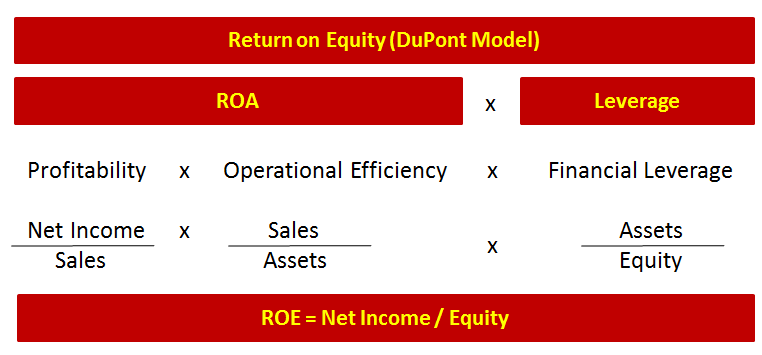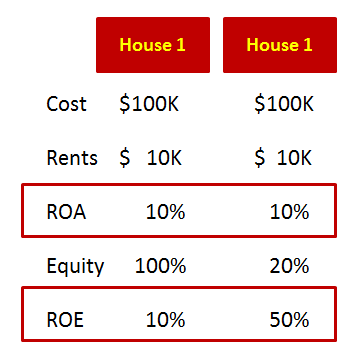ROE (return on equity)
Yes, this is one of the key formulas that most MBAs (yes, including Marketers) remember learning on their path to financial literacy. It is often the best FIRST place to start for financial statement analysis. In simplest terms, it tells investors what kind of % return they are getting on their invested money. Higher the better (usually).
If you only learn a few financial metrics, this is one of them. The formula is simple and worth your memory and understanding: ROE = Net income / Shareholder Equity
- Net income = bottom line on the income statement (revenue-expenses)
- Shareholder equity = Assets – liabilities
Beautifully simple and worth knowing:
- It factors elements from both the income statement and balance sheet
- It applies to all companies and industries (caveat on this point later)
- It can easily be broken into component parts for further analysis
Love DuPont formula even more
This is another way to articulate ROE. Yes, it is named after the chemical company – which apparently starting using this ROE approach in the 1920’s to drive their financial planning and decision making. Their approach is very reductionist and easy to follow:
ROE = ROA (return on assets) x leverage
As I said earlier, consultants love buckets. . . even more buckets here. .
It starts with ROA
Seems like common sense, but getting a good return on your assets is the heart of any business. You have assets (people, plant, equipment, intellectual property, real estate, investments) and you need to get a return. For a consulting firm, projects need to be profitable (client billings > consulting salaries) and the consultants need to be fully utilized. Like the table shows below, the firm needs profitability & operational efficiency. ROA can only be high if projects are profitable and consultants (assets) are fully utilized. If consultants are on the beach, ROA falls.

Leverage helps
This may be counter-intuitive to those not finance-minded, but the more debt you have (other people’s money), you make a higher % return because you get the same net income (profits) with less of YOUR money invested. Same money out, LESS of YOUR money (equity) invested. OPM = other people’s money.
Using the simple example below, let’s assume you buy two identical houses for $100K each. You get annual profit (from rents) of $10K each, so that is ROA of 10% for both. No difference there. What happens if you paid in cash (for full ownership and equity) of house #1, but only put a 20% down payment on the 2nd house? The ROA is the same, but you get more leverage on house #2, and your ROE jumps to 50%.

Leverage can be dangerous
This is obvious, but you cannot just keep chasing ROE returns by borrowing more and more. Eventually the interest payments will be too high, the risk will be too great, or frankly, the banks will stop lending you money. It’s the same over-leverage story that gets repeated every financial crisis in the United States (1930s, 1980s, 2007), when investors borrow too much and cannot pay back their loans.
What is a good ROE?
Although averages do not mean anything, some guys at NYU Stern did some analysis of average ROE by industry here and it looks like this. The average for all industries came out at roughly 15%. It varied considerably by industry, with soft drinks at 27%+ and airlines less than 2%. Big difference.
Final thoughts:
- Use ROE to analyze and compare companies within the same industry
- Look for the REASONS why the ROE is different from competitors (profitability, or asset efficiency, or leverage). What is driving the ROE?
- Look for any accounting tricks which boost ROE in the short-term
- Be wary of companies with 2x ROE of competitors; they may be over-leveraged
- ROE may be misleading for service companies; remember, they don’t have a lot of “assets”, so their ROA will seem unusually high, and the ROE even higher
Great exercise, compare ROE of two similar firms
For example, you could go to Morningstar.com (free resource) and look at the metrics to compare (Honda vs. Toyota) (Walmart vs. Target) (Dollar General vs. Dollar Tree):
- Are the ROE similar?
- If there differences, why?
- What is more profitable per dollar of revenue?
- Who is running their assets more efficiently?
- Who has more leverage? Is it too much leverage?
